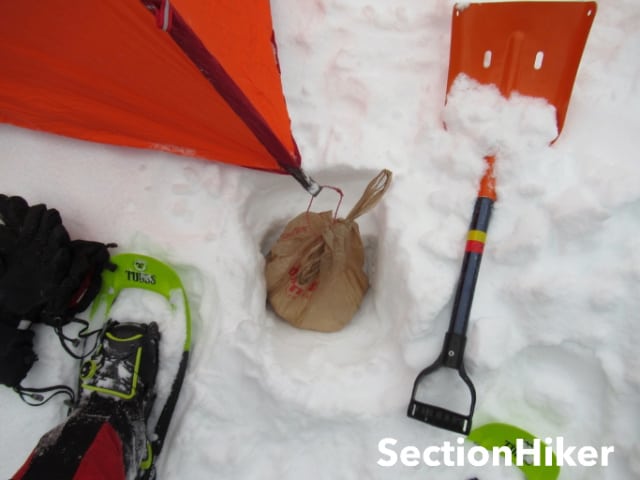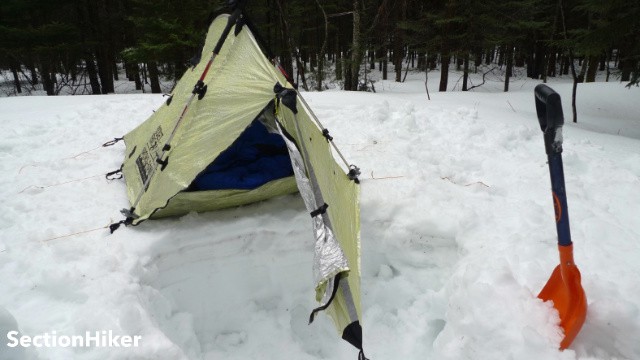
Many three-season tents can be used for winter camping or backpacking if you set them up below treeline, they have strong aluminum or carbon fiber tent poles, and you bring sufficient sleeping insulation and warm clothing to remain comfortable in cold weather. You can also make a three-season tent more comfortable in winter by building wind-breaks or enhanced vestibule areas out of snow if you bring an avalanche shovel with you.
Tent Poles
First, you need a tent that uses tent poles or trekking poles made with aluminum or carbon fiber and not tent poles made with fiberglass. It can be a double-wall tent or a single-wall tent. It doesn’t matter. Aluminum tent poles and trekking poles are strong enough to use in cold weather and under moderate snow loads on the roof of the tent, but fiberglass tent poles tend to shatter in cold temperatures when stressed. What’s a moderate snow load? To be conservative, let’s say 3″ of overnight snow. Less if the snow is saturated with water. It kind of depends on your tent, what shape it has, and how often you bang on the roof at night to keep snow from accumulating on top.

Insulation
Next, you’ll need clothing, a sleeping bag or quilt, and a sleeping pad sufficient to weather the temperatures you want to camp in. While a tent can prevent the wind from robbing your heat, thin tent walls don’t impart any insulation value beyond your clothing or sleep system. We recommend a sleeping pad with an R-value of 5 or more. This can be one pad or two stacked on top of the other since sleeping pad R-values are additive. Most people bring a folding foam pad, like a Therm-a-Rest Zlite sleeping pad, to sit on (instead of the snow) when cooking meals or melting snow, which can also be used as part of your sleep system. See our comprehensive list of sleeping pad R-values to look up your pad’s R-value.
Tent Anchors
When the ground is frozen solid or covered with a deep layer of snow, you can’t rely on regular tent stakes, conventional guyline tensioners, and guylines to stake your tent down for structural support or to prevent it from blowing away in the wind. The easiest thing to do is to grab an 8″ stick if you’re in a forested area, tie a guyline around it, and bury it in the snow so it freezes in place. This is called a deadman. Snow stakes (REI sells excellent blaze orange ones) serve the same purpose, but it helps to practice using them at home before doing it in the snow when you’re wearing heavily insulated gloves.

You can also stake out a tent with skis, ice axes, dismantled trekking poles, or snowshoes. Believe it or not, plastic supermarket shopping bags also make good deadmen. Fill one with snow. Tie it to your tent’s guyline and bury it in a hole you’ve dug with your avalanche shovel.

Avalanche Shovel
Avalanche shovels are compact shovels carried by winter backpackers and campers to create snow structures, including kitchen areas and walls made out of snow. Some have shovel blades that can be separated from the handle to make them easier to pack. You can use a shovel to create snow structures that augment your tent and make it more weather-worthy for winter camping.

For example, the rain fly or walls of most three-season tents, especially those of ultralight tents, seldom go all the way to the ground, but leave a big air gap for added ventilation. This is fine in hot weather, but it lets cold wind blow through the bottom of your tent in winter, which is most unpleasant and robs heat from your sleep system. You can fix this by piling snow up around the base of your tent like a low wall, cutting snow blocks and building a wall to block the wind, or by digging a shallow pit to set your tent up in. It’s Leave No Trace because it will all melt by spring.

It still helps to keep your tent door partially unzipped, especially toward the ceiling, to prevent moist air from collecting inside and creating frost on the walls, but it stops the wind in its tracks.
More Tips
Some double-wall three-season tents are available with interchangeable inner tents with insect netting for warmer weather and solid fabric walls for winter. The solid walls block wind to make you more comfortable. Tarptent provides this option on their Notch Li, Notch, Moment, and Hogback tents.

Most of Hilleberg’s tents have solid doors and walls for this same reason. Big Sky International and SlingFin also sell some tents with a solid inner. You can also find solid inners or partial inner tents on most of MSR’s winter tents, including the 4-season Access Tent Series. That’s just a partial list off the top of my head. If you’re shopping for a new tent and you want 4-season versatility, this is a good option to consider.
SectionHiker is reader-supported. We only make money if you purchase a product through our affiliate links. Help us continue to test and write unsponsored and independent gear reviews, beginner FAQs, and free hiking guides. SectionHiker.com Backpacking Gear Reviews and FAQs
SectionHiker.com Backpacking Gear Reviews and FAQs
Do you bear bag in the winter? Of course lots of animals hibernate, including bears, but not all do…so just curious what you do in the winter.
It depends on the weather and when in winter….but generally, in New Hampshire, the answer is no because it is bloody cold and the bears are asleep. There aren’t any other major predators or nuisance animals worth bothering about. I just put my food in my pack and sleep near it either in the tent or just outside, depending on the tent and how much room we have.
Awesome, one less thing to worry about!
I second Phillip’s comment: “It depends on …” I live further south. So, I use a bear bag, Ursack or canister, even in winter. In West Virginia, we may get temperatures in the teens and up to a couple feet of snow, but usually not for long. Bears no longer hibernate reliably here, not only because winters are warmer than they used to be, but also because they can steal from humans as people spread and destroy habitat. Bears may den up for a few days during cold weather without actually hibernating, then emerge when temperatures warm. Raccoons, mice, etc. are even more active.
Good to know. I live in MN so I’m thinking of forgoing the bag unless it’s unseasonably warm. Thanks for the tip.
I was winter backpacking in the Adirondacks a few years ago, and everyone in our party set up tents near a lean-to. While they went to bag a peak after dark, I went to chat with a guy who was staying in the lean-to. I saw what was probably a fisher run by, which I thought was cute. Then I saw a bunch more running back and forth and wondered what the heck was going on. I went to check on our tents and saw that they’d gotten into the food, even chewing through some tents and backpacks. I was the only one who’d use a canister, and my stuff was fine. One woman was extremely upset, not because they’d gotten her chocolate bars but because she’d contributed to harming the welfare of the animals. So please don’t think that there’s no risk just because bears are probably hibernating.
Leaving food unattended and at a shelter site is just asking for it. Bears aren’t your only concern.
I have both the Tarptent Notch Li and TT Moment DW (with optional X-ing pole), both with “solid” interior.
For winter I much prefer the Moment DW with the X-ing pole I shortened and rand UNDER the fly. The guy points are more numerous and it has fly hem stake loops for high winds. I’ve added these stake lops to my Notch Li with Tenacious Tape reinforcements.
I have used my Moment DW in winter and it has proven very suitable WITH the X-ing pole under the fly for snow load support.
AND I’ve also “winter modded” our TT Scarp 2 by shortening the X-ing poles and running them under the fly, anchoring them in the pole end sleeves there were formerly on lines outside at each corner. Now the poles push down against the peaks of each corner “Pitchloc” triangle. VERY strong and secure.
All these tips are great. I have found that a few hand warmers in your bag make a huge difference in comfort.
if you are using a double-wall tent and the inner tent has a lot of mesh at the top, here is what to do…
Pitch the inner tent. Lay one or more space blankets over the top OVER the poles. Apply the fly to trap the space blankets against the poles. They stop a lot of the heat loss through convection, block a lot of wind and reflect a lot of body heat back to you. The only down side is they make that crinkly sound in the wind or if you roll against the tent wall.
Hey Phillip: Would you consider doing a similar article on hammock camping in winter? Beyond the obvious like buying warmer quilts or doubling them up. I’ve been doing a lot of trial and error in recent years.
Sure – while I’ve done it, I’m not an expert. But I do know someone who is.